American Sabbatical 54: 11/21/96
Mormon Interlude
11/21-11/22.. Coronado, Balboa and LaJolla.
San Diego is a mixed marriage of Spanish beauty and the sprawling uglies, and you can hear
the tongues of internal combustion clacking everywhere. Our first
tour took us over the high-arching Coronado Bridge, by night,
with downtown spread below us to the right. The curving bridge
dominates the skyline to the south like the skeletal outline of
a mountain, trimmed in Xmas lights, and from its height the shipyards,
navy bases, airports, and industrial agglomerations of this major
port are at your feet, and the hubbub shakes the air.
San Diego Bay is a protected basin, approximately eight miles
long by a mile wide, running north/south behind a barrier peninsula.
Ending in a cul de sac to the south, maybe 5 miles from the Mexican
border, the bay makes a fish-hook turn north and west to empty
out to sea. The bluff heights of Point Loma enclose the basin
to the north, while the rest of the bay shore is low-lying. Downtown
San Diego lies along the mainland shore, and from it the skyline
bridge leaps over the bay, at the point where the fish-hook straightens
out. The bridge exits into the mile-square residential settlement
of Coronado on the peninsula, to the north of which is the 2-mile-square
Naval Air Station, and to the south is a long narrow sandy barrier-beach
with the Naval Amphibious Base on the bayside and surfing on the
Pacific. Day and night the air is alive with military aircraft,
all shapes and sizes, thwocking, racketing, and roaring. The Navy
Base and shipyards line the southeastern shore of the bay, and
their illuminated cranes are a herd of industrial giraffes standing
beneath the skeletal mountain of the bridge.
Seen from Coronado by night, downtown is a giant child’s toolbox
and block-set, dumped by the water, and dramatically lit. The
harbor is a hive of watercraft, with ferries and cruise ships
dodging naval vessels and sportscraft. We even saw a flotilla
of two-man sea-kayaks arrowing across the channel in the cityglow.
Walking around Coronado in the balmy dark, each house is a tidy
tropical dream cottage. These are naval officer retirement quarters,
and every detail is shipshape and Bristol fashion. The Mediterranean
plantings are perfect, the symmetries in rigorous order, the brass
polished to a high gleam.. you feel like saluting. The old luxury
hotel, The Coronado del Mar (“Hotel Del”), has steep conical roof
lines, like dark red chateau towers, and sloped awnings which
intersect the grand white facade; and this style is echoed all
over town, in commercial blocks and private homes. But the total
effect is Enchanted Eclectic: Santa Fe timbered overhangs meet
pastel adobe, Bau Haus next to half-timbered California Tudor
down street from Greek Revival Moderne. These aren’t the modest
cots of Venice Beach, or the conspicuous consumtoria of Monterey.
They are the just rewards of a military life, a clean nose, and
a brass hat. 'Tenshun on deck!
We returned to Coronado by daylight (when we could read the suicide hotline numbers on the bridge signs) to draw a few views of this quintessential Calfornication, and the military presence was even more intense. Where else would you find the female joggers grossly outnumbered by shavetailed men with jut-jaws working up a sweat? And was that unmarked security which cruised by three times checking us out? San Diego has the reputation of being a paranoid town. It went into high alert after Oklahoma City, and an atmosphere of armed readiness hovers in the air. No casual driving on base here, the way you can now in Brunswick, Maine. (They’ve removed the nuclear bombs from Brunswick, while there is still protesting about nuclear materials on Coronado.) Redneck survivalism and the military mind polish each other’s boots in this town. I can’t help but wonder if it isn’t the economic abyss between that third world down the trolley tracks and our comfortable affluence which makes the nouveaus nervous. Are we threatened by how high we’ve climbed? Or is this a residual invader guilt? Who’s the evil enemy out there? Whoever it maybe, the Marines are ready to be sent in. We watched them practice Huey lifts among the pelicans.
We ambled barefoot along Coronado Beach picking up exotic shells,
and admired those ungainly crooknecked waddlers wingover in unison
like carrier aircraft and plunge headlong into the rollers. Pelicans
are twice the size of gulls, which look like gliders among bombers
when the jowlbirds come fishing. And the surf-chasing shorebirds
skitter down and back stabbing at the sand. We had the long sands
virtually to ourselves in this shirtsleeve weather. The steady
onshore breeze made it almost as cool as Popham in August. It
was with a certain disorientation that we watched the sun declining
in mid-afternoon over this tropical scene. On the way back through
Coronado we had to dodge golf balls bouncing across the boulevard.
O Sybara. In 15 minutes we were back in the middle-rent hills
of Encanto.
On another day Susan took us to Chicano Park, right under the
entrance ramps to the Coronado Bridge. Putting in the highway
interchanges and the lofty concrete pylons chopped up a barrio,
and the ensuing political fight resulted in the creation of this
grassy interlude. The towering T-shaped bridge supports are covered
in vibrant murals celebrating the cultural ethos and the political
struggles of the displaced. The Virgin of Guadaloupe in her skyblue
robe prays for the world, while Allende and others are martyred
for libertate, and justice. The heroic muralismo of Riveras informs
these street slogans, and Frieda Kahlo is portrayed with doleful
eyes. There are gray-toned pseudo-photos 15 feet tall of proletarian
protesters, fancifully entangled Mayan hieroglyphics in dazzling
tones, mythic warriors and goddesses woven out of images both
Spanish and Indian, and a red Latino Atlas holds the on ramp on
his broad shoulders. An entire forest of civic art. We have seen
splendid muralizing all along this coast, with Oregon showing
perhaps the most wall-art, but this under-road gallery is the
finger-pointing best. With homeless sleepers and Chicano students
reading their books in the park, the liberationist poetry and
the fiery eyed Chicanas overhead echo what happens here. Viva.
When we intimated we were looking for places to sketch, Hannah
said Balboa Park was a neat place to look at. So, one short school
day, the three of us went Parking. There were low gray streamers
settling in around the skyscrapers of downtown as we freewayed
in, and I realized that all the lively pastel and deco delight
we’d enjoyed in downtown is, in fact, set in a matrix of drab
bankbrag towers. On foot in town there is a flavor of European
detail, but out here on the 5 it looks like cold steel, at least
with rain threatening. Which makes Balboa Park all the more enchanting.
We had visited the zoo, arguably the world’s “best” zoo, back
in 86 (and we have problems with animals in captivity), so we
took a pass on Balboa’s foremost attraction, but that’s just the
tip of the sunburg. Museums, museums, and more museums, international
exposition centers, gardens, fountains, botanical extravaganzas.
The rambling parkland looks down on the city’s architectural canyons
from a ridgecrest, then rolls over into it’s private dells. The
institutional buildings are clustered at the center of the 1400
acre enclave, and Spanish Baroque is the dominant style. Encrusted
facades, colonnaded courtyards, sculptural dramatics, high towers
with tiny hipped roofs, all in warm terracotta stucco and raw
sienna tiles.
And it does rain in Southern California! It poured on us. We sketched
under the arches at Balboa, then swam home through the crazed
commuters. When it finally turns dampish, San Diegans run amok,
skidslamming and spinbraking out all over. It was like the first
sunny day in April downeast. Everyone goes nuts. We stopped at
"Ed’s" garage to pick up the retooled Owl, and it looked like
an Arab encampment. Ed’s is mostly a parking lot with a 20-foot
chainlink around it, and maybe 30 cars in various states of disassembly,
with half a dozen mechanics leapfrogging from one to another.
In the downpour umbrellas, tarps, spare hoods, and other improvisations
had sprouted, and the grease was running in streams. But Red jumped
to the touch (new timing belt) and braked like a DCDC dancer.
Not a minute too soon. Vetted and reshod, our loyal Festiva was
ready for Mexico and parts EAST.
It rained hard for 12 hours, then intermittently for the rest
of the day. Hillsides were alive with running mud. Backyard rivulets
made driveways into obstacle courses, and fording the drain-dips
at intersections was a sport to rival steeple-chasing. The locals
reported that 75 fender-benders was about average for a one-day
dousing. By late the following afternoon the sun was peeking and
the flowers starting to bloom. The desert plants, in particular,
are eager opportunists, and some of them chose this moment to
show their colors, mostly iridescent scarlets. We are told that
Christmas marks the beginning of the seasonal flower show here.
Imagine.
After the wrecks were towed off, we went to visit Peggy’s uncle
George, an octogenarian in LaJolla, and on the way made a gawk-stop
at the new Mormon Temple. Up close it is even more arresting than
flying by on 5. Two high-peaked contemporary-Gothic towers joined
by perpendicular stained-glass in cement tracery, the impact was
purified west facade, Chartres. The soaring cement edifice is
totally stripped of external imagery. Only the gilt Angel Moroni
blowing his trumpet to the east atop the east tower, and a golden
cap to the other, relieves the spike-stepped austerity of this
architectural homage.
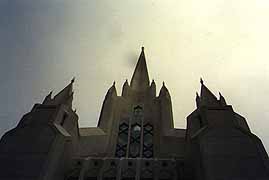
Temple Closup
A powerful statement about modern worship, and we were welcome
to look, but not touch. We walked into the parkinglot from an
adjoining property and hadn’t gone 20 yards before there was a
"guide" angling out to intercept us. A smiling fresh-faced young
Mormon, who confirmed our suspicions that the insides of this
sanctum were for true believers only. Her general wariness, and
the way she dodged some of our questions about the faith, reinforced
our sense of Mormonism as another embattled religion. You might
expect a paranoid sect to find ready converts in this town, and
she said there were 400-odd missionaries in the county. She was
from Idaho.
Brigham Young had visions of Deseret, the Mormon State, maintaining
an ocean outlet, and the Mormon Battalion he ordered into being
marched here from Missouri during the Mexican War, ostensibly
to support the US, and many stayed to maintain a foothold. The
Saints are still here in sufficient force to summon up this noble
building. We’re told that the contractors have a different take
on nobility. Apparently the Mormon overseers on the job insisted
on materials and workmanship beyond the contract, and were notoriously
slow in paying. The prime contractors went bankrupt as a result,
and you’d have a hard job finding a builder in San Diego who would
work for the church. They all smiled when, immediately after sanctification,
Moroni got a direct lightening strike, and looked like a black
messenger from the bank. We thanked the Idaho innocent for the
escort service, and went downhill into LaJolla.
The Torrey Pines rec area had been touted as particularly attractive,
and we aimed the Owl that way. But the perimeter road was closed,
and the cliffroads were asludge with ooze. In the air a hang-glider
was swooping, however, and we hobbled over the freshcut channels
to a hard spot by the edge, and got out to watch. Doesn’t that
look like ecstasy? The updrafts off the Pacific were a mild and
steady 20 knots, and the young man in his flying machine was choreographing
a dance of delight. Sliding and soaring, diving and stalling,
he did a final wingover and touched down like a feather on the
launchpad. Immediately after, another enthusiast, who had been
tinkering with a model glider that had a six-foot wingspan, stepped
to the edge with a radio-cum-antenna jammed in his waistband like
a phallic statement, lifted the glider over his head, and flung
it two-handed over the drop. Pulling out the radio-control unit,
he proceeded to direct the remote aircraft through the full aeronautic
vocabulary. Our imaginations wafted aloft and our hearts exalted.
This time our native guide was a lazy-eyed surfertype with a diamond
earstud and a soft Germanic accent, lolling in his faded BMW beater
and musing on the difference between beach gliding and mountain
soaring. He said it took about a year of training to master the
hang-gliding we’d just seen. I put aside my urge to rush over
and beg a flight, wiped the red mud off my boots, and we made
Owl-tracks.
We still had some time before our visit with Uncle George, who
is very weak and can only take visitors for a hour at a time.
That’s the way I feel about some family, too. So we found his
neighborhood, then went exploring on the shore. The landwash here
is mixed sandy beach and rocky shelving, and we chose the rocks
to ramble on. Fresh runoff silt, and tidesweepings gave a muddy
overcoat to the seasmoothed stones, which were riddled with pothole
pools and eroded swisscheesery. The few solitary boulders looked
like abstract sculptures of seals hauled out for a nooner, and
the tidepools were alive with flora and fauna. Fist-sized sea-anemonies
with colorful tentacle fringes, full of shell fragments, closed
down into globular necklaces of mother-of-pearl. There were glowing
iridescent winkle shells, and half the snail population was actually
hermit crabs busily waddling about. Small sculpin-like fish zipped
here and there, and we encountered two big purple long-legged
crabs bobbing in the wrack. The beached seaweeds out here all
seem to have elaborate bladder evolutions. Even the big kelps
have a grapefruit-sized float at the base of the fronds, which
squishes like a rotten fruit under a curious foot. And all the
leaves, strands, bubbles, lacework, and crust you can imagine
swing to and fro in the tide. Squadrons of pelicans glide along
the shallows in lines and V-s, plummeting occasionally for lunch.
We were getting peckish, too, but it was still too early, so we
auto-ambulated around beachfront LaJolla. This is a quantum leap
upscale from Coronado, and all the contractors’ trucks are new.
I just can’t get hohum about orange tiles and palm trees under
a gentle sun, and these seaside retirements and conspicuosities
are as beautiful as any you could sigh for. The young body-beautifuls
perspiring along the bikeroad look like wealthy acquisitions,
too. Am I just a cynical old letch?
Uncle George might cure you of cynicism. Our brief time with him
was spent in family reminiscence. How he was interned on Ellis
Island because the Polish quota had been filled, and how President
Harding granted amnesty to all in that plight as a Christmas gift.
But his most revealing story was how, as a novice lawyer, he saved
his first client from a trademark infringement suit, and made
a friend for life. A lawyer who can tell you that his first client
became a friend for life might change your image of the Esquirery.
George is the gentlest and kindest of men, and you couldn’t begrudge
him an oceanfront vista for his last years, lawyer or not. But
why do the elderly (or their caretakers) always serve you tunafish?
Tuna as a sidedish with everything (in this case chicken)? Was
it an exotic treat of their childhoods? Is there something particularly
preservative about tuna? Or celery?
These are the sorts of anthropological questions that academic
careers are built on, and we mused tweedily back down the coast
to San Diego. Motoring south along the shore between the enclave
of LaJolla, where the wealthy rub elbows with Scripps Institute
researchers and UCSD scholars, and San Diego, where the Padres
play ball, the settlements go rapidly downscale, into cranky cottage
alleyways and seedy storefront quikmarts. Then you enter the marine
park where Sea World cavorts. This is tourbus turf, with triple-decker
steamboats in glistening gingerbread, and acres of greensward
and flirting fan-palms, but there is also a jampacked trailer-park
on one insular parcel, looking like the lowrent last exit of a
proletarian road.. and we're swept onto the freeway by the pulsing
traffic.. come back to highspeed reality.
(Memo #47)
Nov. 25 - MORMONSCAPES
Who? Chuch of Jesus Christ of Latter Day Saints
What? cathedral
Where? outside San Diego
When? opened two years ago
How? Mormon Brigade during Civil War began large Mormon community
in San Diego
Topics: American religions, Latter Day Saints, Mormon battalion,
Mexican War, proselytization.
Questions: What religions have originated in the United States
or western hemisphere? What role did Mormons have in the claiming
and settling of California?
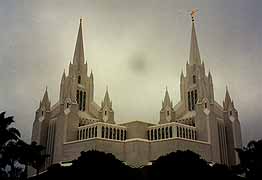
Mormon Temple
The Mormon presence in southern California was first signaled
to us through architecture. As we drove into San Diego for the
first time we saw a white cathedral both beautiful and bizarre
looming up by the highway. With two giant towers, one topped by
a golden angel, the church has the profile of a medieval cathedral.
But where was the central part of the church? There didn’t seem
to be much between the huge towers.The architecture was Chartres
by bauhaus, a simplified and modernized form, still imposing and
incredible. No gargoyles or flying buttresses but the angles and
outline were the same. Stark and impressive. Of course we asked
about it when we arrived at our friends’ and learned that it was
Mormon. We decided to visit.
We drove north several days later, found the exit, parked and
headed for the cathedral doors. The cathedral is dazzling white
with lovely geometric lawns and gardens and fountains galore.
It made us recall the beautiful Bahai temple outside Chicago.
We were met near the doors by a lovely young woman, Sister Eleanor,
charming and polite. No one but true Mormons could enter the cathedral,
she said, but she was glad to walk around outside with us and
answer any questions. She is a missionary from Idaho spending
her two years in San Diego. In response to questions, she said
that women have a whole hierarchy of their own within the Mormon
church and the head of the women’s association is equal to the
Prophet (the current head) and his council of 12 apostles. There
are 9 million Mormons in the United States and a huge colony in
San Diego dating back to the Mormon battalion. She stressed the
fact that Mormons are focused on family and that husbands and
wives, parents and children, are “sealed for eternity”. Converts
to Mormonism believe they are securing blessing for all past relatives.
She was eager to answer any questions and had forms for us to
fill that indicated our interest level and whether missionaries
should visit us at home. She was very proud of the new cathedral,
just consecrated this past spring. It has many meeting rooms.
The largest sanctuary holds about 165 people (which suggests that
it does not have a huge central nave as the structure seemed able
to hold thousands).The angel on top is Moroni (More-own-eye) the
being who brought the golden tablets to Joseph Smith.
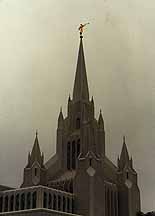
Moroni
Why such a big Mormon presence in San Diego? We knew it was connected
to the Mexican War and the Mormon Battalion that helped claim
California for the United States. So Mormons have been in San
Diego for 150 years! There was a Mormon Battalion Monument in
Old Town, San Diego, and I was sure it would give me the history
of the church in California Off we set two days before Thanksgiving.
Old Town is picturesque Spanish architecture and souvenir shops.
The Mormon monument is a stark and imposing white building across
the street from a square of renovated Victorian houses and the
oldest synagogue in San Diego. As I entered, a woman approached
and introduced herself (Sister Wilson) and offered to give me
a tour.
The building turned out to be something very different from any museum of history or historical site we’ve seen. The entrance hall had a large bronze statue of one member of the battalion and a display case. The latter had the only two artifacts from the Battalion’s march and engraved tablets with the names of the battalion’s members. There is also a battalion flag, spelled battaLION because Brigham Young was know as the “Lion”. Sister Wilson gave me an introduction to the artifacts and the history of the battalion and then asked if I wanted to see a video. There was a small auditorium down the hall where I saw the video on the history of the group. I was to find that this display case, the statue, the film and a small diorama were the only museum parts of the large center.
One of the true American religions, the Church of Jesus Christ
of Latter Day Saints arose from the experiences of young Joseph
Smith in upper New York State. In the early 1800’s there was a
great deal of church activity in his area with different sects
competing for converts. Smith was confused by the variety and
sought enlightenment in prayer and isolation. He had a series
of visions in which the angel Moroni came to him. The teachings
of the church (which build on the beliefs of Christianity) were
manifested through gold tablets that the angel gave Smith, which
became the Book of Mormon. The church was formally established
in 1830 and grew rapidly. Smith and his followers moved west to
Illinois in stages. By about 1838 they had established the town
of Nauvoo (Smith’s “New Zion”) on the Mississippi which quickly
became the biggest city in the western US. The Mormons’ beliefs
- especially communal sharing of wealth through tithes and polygamy
(officially sanctioned by Smith in 1843) - and their prosperity
aroused jealousy and antagonism. A mob attacked the settlement
and killed Smith in 1844. The Mormons now lead by Brigham Young
decided to move west to escape persecution and to settle their
own area. They began their move west in stages in March 1847.
They were eventually to establish the Mormon trail to Utah and
secure the territory for their congregation (by 1850 Salt lake
City had 5000 people and Utah remains today a Mormon stronghold).
The Mormon battalion’s story is part of the Mormons’ move west
in 1847 during the Mexican War.
From Winter Quarters on the Plains, Brigham Young sent emissaries
to Washington to President Polk to see if the government would
commission the Mormons to build blockhouses along the trail west
as they went. Instead, the President asked the Mormons to raise
a battalion to help secure upper California (the current state)
for the US government in the conflict with Mexico. Young saw an
opportunity to win official support for the embattled Mormons
and to perhaps secure a Mormon foothold on the Pacific ocean.
The Mormons raised a battalion of 500 men at their winter quarters
near Council Bluffs who set off for California from Fort Leavenworth
where they received six weeks of training under regular Army officers.
80 women and children accompanied them (laundresses and cooks
who got $7 a month, and army wives). At one point the command
changed and most of the sick and women and children were sent
back.
The march west remains the longest infantry march in American
history: 2000 miles in six months. The Battalion had hard travel
over bad desert stretches, and lost men to dehydration and disease.
At one point they were attacked by wild bulls, at another they
had to dismantle their wagons and haul them piece by piece over
passes. They reached the San Diego area safely and helped repair
and extend the small post. While some men returned to the Mormons
main party and helped in the settling of Utah, 82 men of the Battalion
reenlisted and stayed in San Diego. The strong Mormon presence
in southern California dates from these men. Several of the volunteers
on duty in the center when I visited could trace their ancestry
to men on the Battalion’s roster.
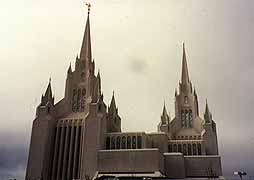
Temple View
After the film presentation, Sister Wilson invited me to see the
diorama under the screen which showed the Battalion moving across
a stark desert. As I asked more questions, I was invited to yet
another room, this one more formal and decorated in pinks and
mauves with ornate floral arrangements on tables around the edges
and fancy chairs and stools. Murals on the walls gave the history
of Jesus’ life. A speaker in the ceiling described the murals.
Sister Wilson pressed some hidden button and a curtain drew back
to show a hidden mural of the second coming which the Mormons
await. She said if I “was interested”, there was more so we passed
into yet another room where murals showed scenes from the life
of Joseph Smith and a speaker told of his life. One wall had charts
and photographs showing the structure of the original Christian
church (Jesus as the head with his apostles) and the parallel
structure of the church of Latter Day Saints today . A glass case
held a replica of the golden plates
(the Book of Mormon) which were given to Joseph Smith by the angel
Moroni. To my surprise, they were not large and heavy as the ten
commandments are depicted. The thick gold “pages” appear to be
about 6 X 8 inches (smaller than an average sheet of paper) and
were held together with two huge rings.
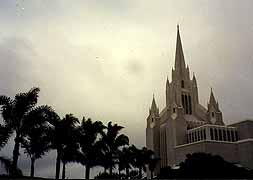
Temple Palms
Sister Wilson was warm and informative and answered all my questions,
but I’m afraid my interest and many questions were seen as indicating
conversion potential. At the end of the tour several other volunteers
converged and they wanted me to accept visits by missionaries
and church literature. It made me reflect on my actions as a traveler.
How to express respect for and a real interest in different religions
without being proselytized? How to visit sacred sites as a nonbeliever
with respect? Perhaps the Mormons are right to close their holy
places to non-Mormons.